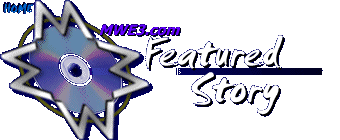THE
BEAT IS THE THING!
An interview with guitar legend...
Les Paul
by
Robert Silverstein
Introduction
written by Pete Townshend
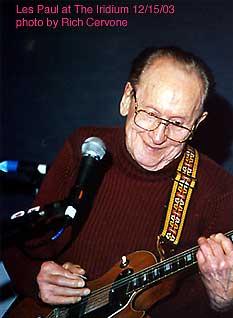 Hard
to know where to start. I have only come to know Les in the last ten
years, but that has been the best part of the entire deal really.
He is such a charming, kind and happy fellow. My pitch for Les always
concentrates on what I feel he did for the modern composer, which
was to invent multi-track recording. Without his invention, little
that we hear today on the radio, and about 90% of what we call 'popular'
music would probably not exist. Composers were - of course - already
using tape machines when Les thought about playing back and recording
tracks using the same physical head on a tape recorder - prior to
then thought impossible. But all we could do was bounce from machine
to machine, this deepened the layers sending them, ultimately, into
distortion. Working as Les Paul and Mary Ford did, on an 8 track vertical
head stack, many more layers could be recorded with very little loss.
It changed the way we record, the way we write and the way we think
about music. It made music-making accessible to untrained musicians
and intuitive engineers. The mathematical mysteries around music notation
and broadcasting studio techniques began to fall away. His guitar
designs stand alongside Leo Fender’s as being more than guitars,
they are pinnacles of modern contemporary American design - as quintessential
as the Jumbo jet, the 57 Ford Thunderbird, Falling Water and Ricky
Nelson's beautiful face.
Hard
to know where to start. I have only come to know Les in the last ten
years, but that has been the best part of the entire deal really.
He is such a charming, kind and happy fellow. My pitch for Les always
concentrates on what I feel he did for the modern composer, which
was to invent multi-track recording. Without his invention, little
that we hear today on the radio, and about 90% of what we call 'popular'
music would probably not exist. Composers were - of course - already
using tape machines when Les thought about playing back and recording
tracks using the same physical head on a tape recorder - prior to
then thought impossible. But all we could do was bounce from machine
to machine, this deepened the layers sending them, ultimately, into
distortion. Working as Les Paul and Mary Ford did, on an 8 track vertical
head stack, many more layers could be recorded with very little loss.
It changed the way we record, the way we write and the way we think
about music. It made music-making accessible to untrained musicians
and intuitive engineers. The mathematical mysteries around music notation
and broadcasting studio techniques began to fall away. His guitar
designs stand alongside Leo Fender’s as being more than guitars,
they are pinnacles of modern contemporary American design - as quintessential
as the Jumbo jet, the 57 Ford Thunderbird, Falling Water and Ricky
Nelson's beautiful face.
PART 1 - AT THE IRIDIUM DECEMBER 15, 2003
Guitar enthusiasts, this writer included, often contend that the
great pop music revolution of the 20th Century began with The Beatles
in ‘63—or perhaps, even more accurately with the incipient
works of mid-‘50s rockers like Berry, Holly & Perkins. That
said, it’s worth reexamining the third concept that it all began
with 20th Century guitar icon Les Paul. Huge number one pop smashes
by Les Paul & Mary Ford like “How High The Moon” (March,
1951) and “World’s Waiting For The Sunrise” (August,
1951) had a major impact on both Lennon & McCartney and as far
as his effect on instrumental pop goes check out spectacular Les Paul
guitar masterpieces like “The Carioca”, “Lady Of Spain”
and “Brazil”. With a repertoire of guitar works dating back
to his earliest Decca sessions on May 11, 1936, it’s an understatement
to say Les Paul had a major influence on many guitarists of his heyday
while also providing a future roadmap for upcoming ‘60s guitar
rockers like Duane Eddy The Ventures and in the U.K., starting in
‘59 with The Shadows. To the delight of his many fans and worshipers
Les still keeps the faith at his weekly Monday night live celebration
at The Iridium Jazz Club on the corner of 51st and Broadway in the
heart of Manhattan—the very spot where Les began his mythical
journey to the top the pops and straight into the hall of fame of
guitar design and innovation. Performing on stage with Les each Monday
night at the Iridium, The Les Paul Group—Lou Pallo (rhythm guitar),
Frank Vignola (guitar), Nicki Parrott (upright bass) and John Colianni
(Steinway piano)—put the finishing touches to a galaxy of timeless
Les Paul standards, some goin’ back to the WWII era. For this
interview, caught in person before his early show at the Iridium on
December 15, 2003, Les spoke with Robert Silverstein from 20th Century
Guitar magazine and www.mwe3.com about his debut album, The New Sound
and much, much timeless music history.
RS: Les, I would like to conjecture that without the early instrumental
guitar innovations on your New Sound we might have not had
the big instrumental guitar boom of the late ‘50s and early ‘60s.
It had to start somewhere!
LP: (laughter) We started something, didn’t we? (laughter)
RS: It’s incredible...
 LP:
Yeah. Well I’m very happy it started. It’s great.
LP:
Yeah. Well I’m very happy it started. It’s great.
RS: One of your quotes, if you don’t mind me paraphrasing, "I
learned a long time ago that one note can go a long way if it's the
right one." Could you say something about what guitar aficionados
still call the ‘Les Is More’ philosophy of carefully choosing
just the right notes and always working with a strong melody?
LP: Ahh...Jeff Beck would be one that comes to my mind right away
but there are many great technicians out there but there’s less
of the ones that are the wiser that choose exactly...of all the notes
that you can play you only have to play one. If it’s the right
one you can make a person cry, you can make ‘em laugh. It’s
amazing how important that note is, that you hit the right note. And
they don’t know it but the audience reacts to it. Count Basie,
the longer he was in business, the more he found out that one note
meant more than ten. And I don’t say that just because of my
handicap with my hands and the fact that I can’t play the faster
things I used to play. But I look back now at some of the old recordings
and I say, ‘well, I would have been alot better if I’d have
played less notes.’ (laughter)
RS: Collector’s Choice put out a great CD in 2003 from Les Paul
& His Trio called California Melodies.
LP: Yes...
RS: Have you seen that?
LP: No I haven’t, but I know of it of course.
RS: The California Melodies show ran from 1932 to 1947 and
you worked with orchestra leader Frank DeVol during the 1944 season.
LP: Harry Zimmerman...right, right...My job was to pick the jazz artists
to be on the show. So that’s where I would pick Art Tatum and
I would pick so many of the great, great soloists to play on California
Melodies. It was a lot of fun to work with.
RS: That was recorded right around WWII.
LP: That’s right.
RS: Do you remember what the mood of the country was during those
first post WWII years? I guess people were looking for kind of like
a fresh start and your music was just coming in...
LP: You know, what I saw right after the war...I saw the change taking
place when be-bop was coming in and the style of music was changing
where the rhythm wasn’t important and the melody was very busy
and played anything but the notes that the average person wished to
hear. And the soldier that came back after the war was terribly disappointed
to find that he was listening to music that he didn’t understand
but he couldn’t dance to it either because the rhythm was very
much a minority. And then it was over a period of time that it began
to change and they said, ‘well, we’ve got to change this.’
And it was the younger generation who came along and made the changes,
made many of the changes where they said, ‘hey, we want a strong
beat.’ When we were with Capitol Records, one of the most important
things—and I used to preach it...to myself, to Mary, to Capitol
Records—was you should beat your foot so hard that it hurts (laughter).
Actually, you want to beat the foot. The harder you beat your foot,
the better it is. The more you make that rhythm drive, the better
it is. And that’s where “How High The Moon” came from.
RS: One last thing about the California Melodies CD was there
were those cool voice overs on those live broadcasts. Like the announcer
on the show would come on and introduce you with something like, 'The
beat is the thing...and now here's Les Paul and his trio...'. Was
that a popular thing to do during those years? 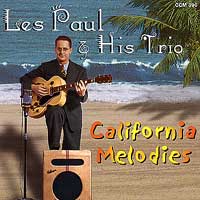
LP: Yeah...alot of those voice-overs were put on since then, not on
that show. But what we did have though was we had two studios, one
studio had the orchestra and the soloists and the other one had all
the glee club and the singers. And so we actually had two studios
working together at the same time. And so we had maybe 65 or 75 people.
So it was one big, big, big, massive bundle of music. It was a very,
very good show. A very good show. Frank DeVol was great and so was
Harry Zimmer.
RS: I was amazed that Decca didn’t even want to release “Lover”
so you went to Capitol Records with the record in 1947. First Decca
missed out on some of your best stuff (Les gives a good laugh) and
then ten years later they missed out on The Beatles too!
LP: (more laughter) Well that was Dave Kapp. And Dave Kapp, I called
him up and said, ‘Say, I got something new for you.’ And
he came over and listened to it and he said, ‘Well, I’ll
try once around the block with it, but that’s all I think it’s
gonna do.’ And so I said, ‘Obviously, you’re not the
place I’m looking for.’ And RCA made an agreement...Oh,
they leaped on it. RCA leaped on it but the union was such a problem
that in the meantime, I packed all my stuff up and left NBC to walk
out the front door and saw them putting a sign up across the street,
on Vine Street, above Wallachs music store, that said Capitol Records.
It was just a canvas...a thing the painters put up there. (ed.- just
now our interviewers cell phone goes off and it gives Les a good laugh
watching the interviewer scramble and fumble to find his cell phone,
which is, unknown to him, still attached to his belt buckle!) So when
I walked out of NBC studios, I left the RCA deal pending. I walked
out the front door with a bundle of records under my arm, saw Capitol
just starting across the street. So I walked over to them, backed
up the stairway and the whole nine yards and I’ll be darned if
Jim Conklin didn’t say—he wrote on an envelope—you
got a deal.
RS: When you put out The New Sound in 1950 it was so amazing...
LP: It was ‘46!
RS: It came out in 1946?
LP: The New Sound was ‘46.
RS: It came out in 1946?
LP: No, it didn’t come out in ‘46, it came out in ‘48,
but it was ‘46 that I made the records. So the records were made,
they just were not released until I made that deal.
RS: So all those records that you backed up the stairs...
LP: Not all of them! Not all of them. If I take “Tiger Rag”,
take “Some Of These Days”, “World’s Waiting For
The Sunrise”, “Sitting On Top Of The World”...a mess
of those records were made way prior...
RS: Prior to meeting Capitol...
LP: Sure, sure
RS: Wow. I grew up in New York and I can just imagine after
The New Sound came out and people were able to buy some of
the tracks were people constantly stopping you in the street and asking
you, ‘how in heck do you do that?’.
LP: Yeah, yeah. Including Django Reinhardt! (laughter) Django said
he heard it the first time and he says, ‘oh my god, what’s
happened?’ And he was taken by it too, yup.
RS: My father is a huge fan of yours. He remembers “The Carioca”.
I read the first time you played “The Carioca” was out at
LaGuardia Airport...
LP: I was, right.
RS: And you were playing it for others parked and watching the planes
come in. And you had the electric guitar out there?
LP: Yeah, it was hot. It was in July and we’d sit in the car
with the top down and I’d just play the guitar and practice “The
Carioca”. And while I was doing that, the people were honking
their horns and applauding (laughter). They were parked there watching
the planes come in too.
RS: That was off The Grand Central I guess.
LP: Yeah, yeah...
RS: After you put out The New Sound, you put out The New
Sound II and you started mixing in the vocals.
LP: That’s when I went to Capitol Records and said in order to
make this thing really work, I want to make Mary part of it. And they
said, ‘why do you want a Wisconsin dairy maid singing on your
records when you can get anybody you want?’ And I said, ‘well,
it’s just that I think that Mary fits this situation perfectly
with me and you just can’t play instrumentals over and over and
over.’ The thing is, it’s nice to have “Vaya Con Dios”,
it’s nice to have “World’s Waiting For The Sunrise”
but it’s also nice to have an instrumental like “Meet Mr.
Callahan”...or something else—“Brazil” or “Caravan”
on the other side. So, in order to have the variety, it was wise to
have.... And so Capitol said, ‘well jeez, you can get a clarinet,
you can get a piano player, you can get a trumpet player, a violinist.
Why do you want to lock in to one person?’ And I said, ‘because
I think this’d make a good team.’ We were right.
RS: Mary has one of the great voices of any American female singer
I ever heard.
LP: She was a phenomenal singer. She had a great ear
RS: Another favorite is an instrumental off The New Sound II is
“La Rosita”.
LP: Oh!...we’re going to play that tonight.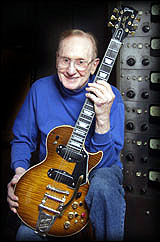
RS: Did you have certain instrumental songwriters who wrote for you
or did you seek out covers?
LP: No, no. It’s just sounds that I would hear. “La Rosita”
happened to be one that was not a terribly big song in that era but
it was one that I learned first and it's one of the first songs that
I ever learned to play on the guitar was “La Rosita”. And
I stuck to mostly standards because I knew that the people had a better
chance of playing a song that they knew and that way you could improvise,
you could get away from the melody a bit more than you could with...a
new song and you wander from the melody and they don’t know the
song. But if you take “Over The Rainbow” or “Stardust”
or “How High The Moon” and you wander a little bit away
from that one...“The World’s Waiting For The Sunrise”,
you don’t get hurt. The idea is not to leave the customer...I
preach it to my group all the time. Just, if they’re going to
leave the melody, either ya got something better, or don’t play
it. (laughter)
RS: When you went to Capitol, “Lover” was released in February
1948, you played everything on that song.
LP: Ya...
RS: That was incredible.
LP: Thank you.
RS: I remember the first Paul McCartney solo album with the instrumental
tracks. You were doing it better than Paul 22 years before he did!
LP: (laughter) Paul...when he comes over here...he comes over and
comes on the stage and he says, ‘if it wasn’t for you there
would be no Beatles.’ And he says he and John went in an audition
and were turned down. And the boss of the club over in England said
to Paul and John Lennon, ‘come back with “How High The Moon”,
“World’s Waiting For The Sunrise” and you’ll have
a chance.’ And they learned both songs and came back with them
and got the job. So he says, ‘you’re responsible not only
for multi-track but (laughter) for The Beatles.
RS: And also without you being on Capitol, they might not have achieved
the status to sign The Beatles. You were saying about Capitol, you
said you wanted to start with "Lover" which you throught
was the weakest track you had then.
LP: That’s right.
RS: Which tracks were you holding back as the strongest?
LP: Well I was holding “The World Is Waiting For The Sunrise”,
I was holding “Tiger Rag”, I was holding “Alabamy Bound”.
I was holding back a whole bunch of songs. “Just One More Chance”
and it just goes on and on and on. But the one that I thought would
be...it would be a great idea...because if you’ve got 21 songs
to hand Capitol and they pick the best one, you can only go down!
And so I said, well the way to do that is to pick the weakest one
and it would be such a surprise to them. I’d already tried this
on Artie Shaw and several other friends of mine, including Mary, and
when they heard “Lover” they’d flipped out on it. And
so I said well why don’t we do it with “Lover” first—that’s
the weakest one of the 21 that I have and then we could build. We
could get stronger and stronger and stronger as we went along.
RS: ‘Cause you were waiting to put out “How High The Moon”
I guess?
LP: Oh boy. And Capitol was against it.
RS: And you proved them all wrong, because the Les Paul & Mary
Ford version of it went to number one.
LP: Well...they said eighty five songs, none of them a hit. What makes
you think “How High The Moon”, with such crazy lyrics as
that, that don’t make sense. What makes you think your record’s
any different than their’s. I said because of the strong, driving
beat. And I said, that’s the key to this thing—is a strong,
driving beat. And I’m doing it with no drums.
RS: The Capitol box set, Les Paul: The Legend & The Legacy
is out of print. I wrote here it covers everything from A to “Zing”
(laughter). Do you have the masters from that?
LP: I have the masters, yeah.
RS: Would you consider ever doing another box set with other rarities?
LP: Sure, sure. If the good lord gives me my hands I’d do it.
Sure.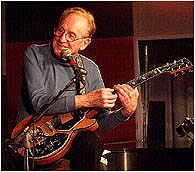
RS: I saw on Amazon.com there’s one copy of the box set going
for almost $200.
LP: Oh geez...(laughter)
RS: But it’s without the actual box casing.
LP: (laughter) No box!
RS: Just the CDs. After you left Capitol, at least over in England,
EMI were working with a band called The Shadows.
LP: I don’t know about ‘em.
RS: I was thinking they were so influenced by you.
LP: Really?
RS: Because I was going back and playing some of your Columbia recordings,
like “Big Eyed Gal”, from 1958. And The Shadows hadn’t
even made their first album yet. And I heard that and I was thinking
The Shadows had to be influenced by that.
LP: Yeah, well that’s where the big change was. Because of tax
reasons, the way the contract was written we had to leave Capitol
after ten years. In other words, if we wanted to have this particular
contract stand up as a legitimate and a successful contract we had
to agree that we would leave Capitol after ten years. So ten years,
we left Capitol to go with Columbia. And not too bad, because Columbia
had all the Capitol people (laughter) working at Columbia.
RS: Mitch Miller was up at Columbia then.
LP: Yeah, yeah. A surprising thing happened and that is, is that the
more I progressed in having better equipment and having a choice of
doing many more things, the less of the original sound remained. And
consequently, I didn’t realize that till years later that the
original was the better way to go. And it was only because we were
so handicapped that we couldn’t make it complicated. And later,
as we got more toys to play with, and more EQ’s and more filters
and more echo chambers and all the things that you wished you could
have had when I made all the hits...by the time I got with Columbia
I could do anything. I had all this modern technology coming along,
that gave you a wider choice. And a wider choice made for a record
not as good. (laughter)
RS: Still, the Columbia stuff sounds pretty good to me. For instance,
on “Big Eyed Gal” do you remember who you played with. Was
that just you?
LP: The only ones I remember on “Big Eyed Gal” was me. (laughter)
RS: You played the whole thing yourself?
LP: Yeah, uh-huh.
RS: Man oh man...no wonder where McCartney got alot of his ideas from!
(laughter) And The Shadows! Also from that era, “The Poor People
Of Paris” was another beautiful song.
LP: Oh, thank you. There were so many...The problem we had, as I look
back, is that we’d have two hits at one time. And at one time
we had seven hits on the top ten. Of the top ten, seven of them were
us. And the problem we ran into is that we had too much material and
we’d have to hurt ourselves, to kill ourselves by covering...by
putting a record on top of one that’s just becoming a hit. So
we were held back. Like “Fly Me To The Moon”, I had that
and I had “Three Penny Opera”. I had that and owned it.
And there just wasn’t any place to put it out at that time because
we’re already jammed with hits. And so I can’t complain
that that isn’t great but it was a funny position to be in where
you got more hits than you can put out.
RS: That was during Capitol?...
LP: That was during Capitol and Columbia.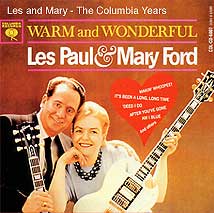
RS: Your home is described as and I quote, “the dig of a lifetime
for the recording archeologist”. (laughter) Is the Smithsonian
still after you?
LP: That’s where it’ll go. It’ll go in the Smithsonian.
(laughter) The weather right now in New Jersey, they have a snowstorm
and it’s melting and the areas, the rivers are overflowed and
everything else. And I said one thing could happen. The river could
rise so high as to wash away about (laughter) two thousand tape machines
that I’ve got setting there. Yeah...
RS: Oh my god...two thousand tape machines...?
LP: No, I’m just kidding. It’s a vast amount of stuff.
RS: I remember you said that alot of equipment is still in use. For
instance, you said that for the CD box set on Capitol, the tapes were
played back through your eight-track machine.
LP: Yeah, we want to keep all the original stuff. See, the great,
great hits that we had, none of ‘em were made in the studio.
They were made in the back of a filling station, or in a dressing
room or in a hotel room, at a bar somewhere, a basement, kitchens...
Never in a studio. And they were never completely made in one particular
place because I would start “The World’s Waiting For The
Sunrise” on Northern Blvd. here in New York and I remember taking
it to Las Vegas, added one more part to it, and finished it in Chicago.
And so that covered many states. That one song had parts made of it
in different cities.
RS: And that gets back to the show, your NBC radio show, “The
Les Paul Show”.
LP: That’s the show I’m talking about.
RS: Your NBC radio show “The Les Paul Show”, which ran for
23 weeks in 1949-50, was great. You call them sustainer shows.
LP: They were sustainers. What I did was, I wrote the material...the
dialog, the kidding around with Mary and the Les Paulverizer and all
the fun we had with that. The idea of the show was that you’re
not going to sit there and get technical with your listener and tell
‘em about multi-track machines and sound on sound and the heads
and frequencies and the biasing and all that. So I thought up the
idea of just calling it the Les Paulverizer and with this magic box.
And lo and behold, when I took the radio shows to Capitol, Capitol
bought ‘em and the hits started to happen. Then the next thing
that happened is that you have to appear in person. When you appear
in person...I said, well Jiminy Christmas, what I gotta do is make
a Les Paulverizer box and actually, physically make it do what I said
it did. And so that’s where that derived from.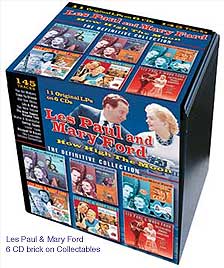
RS: I was just listening to them last night. Especially “The
Gas Guitar” episode. (laughter) Mary sang “Besame Mucho”
on the gondola and then “Smoke Gets In Your Eyes” and “Night
And Day” and then you fell off the boat and then she woke you
up from the dream.
LP: Yeah, those were fun things because we’d make all the dialog
we’ll say, in one afternoon. And that night we’d make “How
High The Moon”, the next day we’d make another couple, three
songs. It took us maybe two days to do four number one hits and the
dialog, engineer the show, perform on it, get it out, put in the mailbox.
And I would just walk to the corner in Jackson Heights. I would just
walk to the corner of the mailbox, drop it in there and then send
it and the darn thing got there!
RS: The tape, right?
LP: The tape got there!
PART II - BY PHONE FROM MAHWAH, DECEMBER 17, 2003
RS: Hi Les. Do you have a few minutes to finish the interview? I can
call you at a better time...
LP: Yeah, we can do it, let me get to another phone, okay?
RS: It’s been raining like heck out here. How’s it out in
Jersey?
LP: It’s fine.
RS: First I want to tell you I had a great time watching you play
at the Iridium last Monday night.
LP: Thank you.
RS: Your band is really great and it’s so much fun watching the
guest artists that come up on stage to join you. That gal with the
French accordion music was a lot of fun. (laughter)
LP: Yeah it was.
RS: How do you decide which artists from the audience are going to
come up on stage to play with the band?
LP: Ahhh... I don’t decide until we’re up on the stage.
I have no idea who is in that audience. I know those personal ones
that come back stage. I know they’ve been there before. Other
cases, someone that I trust their judgment, say there’s a great
tenor man in the audience. Something like that. But usually, I go
up on the stage and adjust to the people. What they’re all about.
And then start throwing some feelers out like just say we have guests
and I know that there’s four or five guests standing in the wings
that are very good and very competent. And the ones that I don’t
know about, and that’s your question, would be those that you...I’d
preface it by saying if we call ‘em up here and they don’t
do well, we tell ‘em they’re wanted on the phone. We just
do the best that we can with ‘em and hope they improve (laughter)
before we ask ‘em to come up and play again! (laughter) Once
in a while they’ll be one that isn’t so good or something.
Like the accordion player. I knew we were gonna have alot of fun with
that because no matter who come up with an accordion, if he was great
or if he’s not so good...doesn’t matter. Just the fact that
we got an accordion there gives us the chance to have a lot of fun
with it because accordion is just ahh...looked upon as ahhh...a dog.
You know...a turkey. We could have alot of fun with it. I have perfect
pitch. I pitched my accordion in the city dump. We can always get
the audience to join us in having some fun. When they come up there
of course, we don’t know what we’re getting into till they
actually come up and do it and the audience is sharing the same surprise,
the same wondering as we are...what have we got here?...And we adjust
to it. If she’d played polkas, we’d be play her the best
damn polka you ever heard. And if she was a hillbilly, well we would
go hillbilly, and if it’s jazz, we go jazz. We go any way they
wanna go, or are capable of.
RS: That fella that came up on stage and jammed on “How High
The Moon” with you was amazing. He hit all the right notes. Did
you rehearse at all with him?
LP: No...no. What we do in a case like that...just say, well...why
not? I can see what he’s got. If he’s got nerve enough to
get up there and follow that piano player, our piano player, he has
to have a lot of nerve. He’s got to be pretty good, otherwise
he’s just stupid. And, if people...they judge this also. And
you notice that the audience is very kind to him if he played pretty
good, they’ll encourage him to play his best.
RS: He was really good.
LP: Yes! The people, they were rootin’ for him. The guy that
was up there, our piano player, John Colianni is so great that nobody
wants to come up and follow him. And if someone does come up there,
the audience is going to root like hell for him and hope like hell
that he’s great and give him that extra adrenalin. And it’s
a fun thing. We’re not out to hurt anybody, we’re out to
help ‘em. And it might be a young kid, thirteen years old and
it’d probably be one of the biggest days of his life. Make him
happy, make his parents happy and the possibility is there that one
day, he’ll be president. Try to give the guy the break that you
wish you got when you were a kid, or did get.
RS: And you say you don’t work off a set list. You say you like
to keep them on their toes.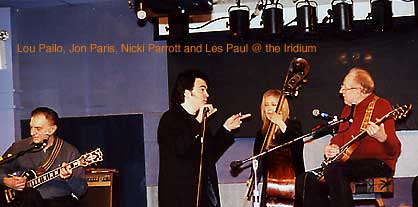
LP: I never tell ‘em. Never tell ‘em what I’m gonna
do. Because if I did then the audience recognizes this is planned...rehearsed,
that this is a show. This way, it sounds like we’re all in the
living room carrying on a conversation. Everybody feels that they’re
part of us and they can say, express anything they wish to say and
we welcome. So it’s not like going to the Paramount theater,
the Palace theater, Music Hall...And you sit back there and this is
what you get, okay? Like Stan Kenton says, ‘my job is to teach
‘em about music.’ And I says, my job is to give ‘em
what they paid to get in and wish to hear. So it’s a different
approach, that’s all. Yeah, you can lay down some stuff...and
I do! Or I lay it out there and if they kind of applaud or kind of
laugh or if it’s one of those things, I get rid of it in a hurry.
I can’t force it down their throat. If they don’t like castor
oil, I’m not going to give it to ‘em. They paid to get in
and they’re hungry for a laugh and a good time and enjoy the
music and wanna come back and hear more.
RS: Also I noticed the president of Gibson guitars was in the audience
this past Monday. What was his name?
LP: Henry Juszkiewicz.
RS: Any news from Gibson?
LP: We’re working on things all the time. We had dinner together
and we discussed all the things that are going great and all things
we plan to do to make it better. At the closing of the discussion
was that we gotta get together real soon and do even more. So even
though it’s doing way beyond our expectations and we know it’s
gonna be great but it can always be better and we’re talking
about including more and more. It just keeps going, getting bigger
and bigger and better. And alot of our discussion is about improving,
improving whatever we’re doing. We listen to what the customer
says, mostly to the ones that have some suggestion or criticism or
something to tell us that we either could do better or we’ve
missed or might think about adding to. That kind of a thing. The president
and myself, we’re strong believers that their customer is right
and what he wants is what we should give him.
RS: Your Monday night show at Iridium, you mentioned Paul McCartney
showed up there.
LP: Yeah, he shows up all the time.
RS: What did he play with you, “How High The Moon”?
LP: Yeah, yeah...whenever he gets up on the stage he ends up talking
about how The Beatles started and how he and John got their first
job and the boss said well, ‘you guys go home and practice’,
he says, ‘come back with “How High The Moon”, “World’s
Waiting For The Sunrise” some Les Paul and Mary Ford stuff’.
And he said, ‘that’s what we did. That was the first numbers.
That’s how we got our job’. And he said, ‘if it wasn’t
for you inventing the multi-track, there would be no Beatles.’
Paul is a very...not only is he a very nice guy but you don’t
have to force him to get up on the stage and talk. He’s a very
friendly and likable nice person. And his wife was just great. His
new wife is just great. She got up on the stage and we kidded around,
and boy she’s quick. And we just had a wonderful time. Paul got
up, the last time he come in, he got up twice! I said, ‘heard
enough of you Paul, (laughter) I wanna talk to this gal that you’re
going with.’ I said, ‘are you foolin’ around with her,
or you got something going?’ (laughter) He says, “I’m
going to marry her”. So I asked Heather to come up on the stage.
So she came up and we started talkin’ and then he took his tuxedo
coat off and got back up on the stage and we talked some more. He’s
just great. He’s a very, very nice person.
RS: I saw a picture from when Billy F. Gibbons from ZZ Top joined
you on stage at the Iridium.
LP: Yeah, he’s fun too to have on the stage. I can’t think
of one that hasn’t been on that stage that the public just doesn’t
enjoy. I don’t think there’s been one that they don’t
see something good in.
RS: That area of Manhattan that the Iridium is in in pretty interesting.
I remember growing up around there. My father owned the coffee shop
in the old Victoria Hotel.
LP: Oh, really? That’s great.
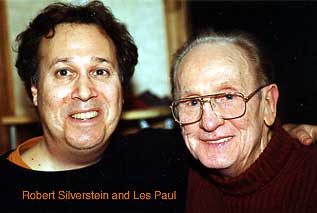 RS:
And the Colony Record shop was another favorite place for me to hang
out.
RS:
And the Colony Record shop was another favorite place for me to hang
out.
LP: That was the pulse of the world. The Brill Building and that whole
area in there. See, I worked at 53rd & Broadway, where Letterman
is. I worked there for five years. And when I came to New York, that’s
where I got my job. Paul Whiteman was on the third floor. Fred Waring
was on one of the other floors. And I joined Fred Waring, was with
him five years there. And of course we played 52nd Street, the Onyx
Club and the Little Club. And we played that whole thing on 52nd Street.
And of course, The Paramount so, between NBC and the Christmas tree,
the ice skating rink, New York has just been the heart of my life
has been there, like you...you were like born in Times Square!
RS: Yeah, I’ve been living in New York most my whole life. Now
I’m living out near where you used to live near Jackson Heights
off Northern Blvd.
LP: Oh, you’re out there. Jackson Heights was where all the musicians
that I can think of...it seemed like the whole world lived in Jackson
Heights back in the ‘30s. And so the ‘30s and the ‘40s,
that was a haven of all The Bob Crosby Band, The Fred Waring Band,
the Guy Lombardo’s and the Benny Goodman’s and it just went
on and on. All the great, great players in New York, from all over
the world! They would come to this area and they’d rent an apartment
in Jackson Heights. And that’s where I...my ill-eagel radio station.
And we broadcast for four years there and just had all the great musicians
there. It was a terrific time...
